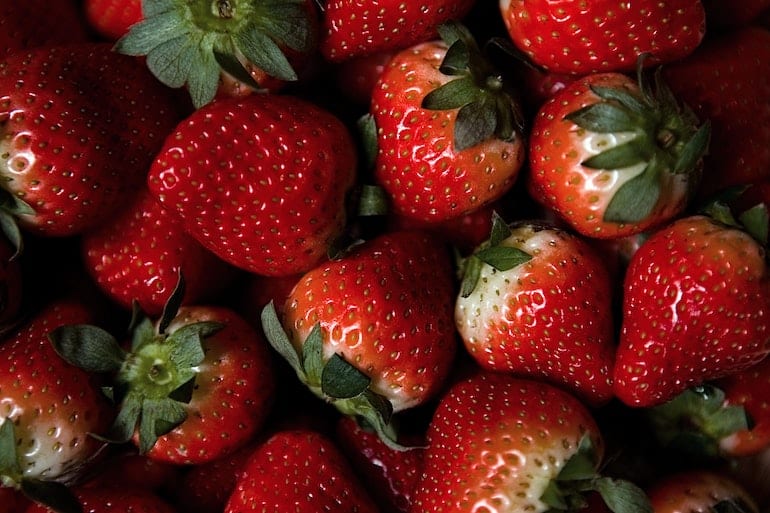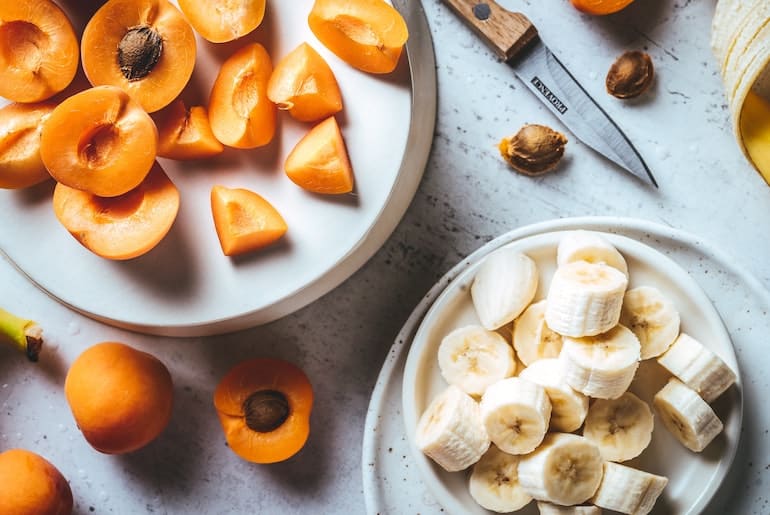You’ve heard that sugar is bad for you—but is fruit sugar bad for you? We dive into the research on this popular health question and tap experts to get their take.
Sugar is no stranger to nutrition headlines. Over the past 10+ years, it’s been called out for being as addictive as cocaine and excess consumption has been associated with everything from type 2 diabetes to high cholesterol to full-blown cardiovascular disease. This is why you—and many of your health-conscious friends—probably do your best to limit added sugars from sources like sodas, candy, and other highly processed foods.
But what about the naturally-occurring sugar from fruit? Is that bad for you, too? If you follow any wellness influencers on social media, you’ve probably witnessed strategic hacks like swapping out the banana in a smoothie for frozen cauliflower to lower its sugar content or only eating “low sugar” fruits. But how necessary is this? And could hyper-focusing on avoiding sugar from fruit be narrowing your nutrient intake?
Below, we dive into the research on fruit sugar and offer guidance from actual nutrition pros on whether limiting fruit to lower your sugar intake is really a good idea.
Added Sugars vs. the Sugar in Fruit: What’s the Difference?
Simply looking at how much sugar a food contains isn’t necessarily an indicator of how healthy or unhealthy it is. What you really need to be mindful of are those sneaky added sugars.
Added sugars are the ones manufacturers add to food products such as sodas, cereals, flavored yogurts, and desserts to boost flavor or extend shelf life. The caloric sweeteners you add to your coffee and oatmeal also count as added sugars. These added sugars come in many forms—from evaporated cane juice to high-fructose corn syrup to honey to coconut sugar—and research clearly demonstrates they’re associated with a slew of problems, including high blood pressure, inflammation, weight gain, diabetes, fatty liver disease, and an increased risk of cardiovascular disease. That’s why the Dietary Guidelines for Americans 2020-2025 suggest limiting added sugars to less than 10 percent of your total calories per day. The American Heart Association suggests an even stricter limit of less than six percent of your total calories. That works out to less than 24 grams of added sugar per day for most women and less than 36 grams per day for most men.
The sugar naturally present in fruit, certain veggies, and other whole foods, however, is considered naturally occurring sugar, and there are no official guidelines on limiting this—most likely because fruit and veggie consumption is almost always associated with health benefits, not risks. For example, a 2017 research review found that fruit and vegetable intake was associated with reduced risk of cancer, heart disease, and death; and other research suggests that fruit consumption may have an anti-obesity and anti-diabetic effect.
It may seem contradictory that a sugar-containing food group like fruit could offer these impressive health benefits, but there are several potential reasons—namely, the way sugar is packaged within fruit and the presence of additional nutrients. “Fruit contains moderate amounts of naturally-occurring sugars, which are bound up in fibrous cell walls that take more time to digest and absorb than the added sugars found in hyper-processed foods,” says Desiree Nielsen, RD, author of Eat More Plants and Good for Your Gut. “Additionally, they are packed with vitamins and phytochemicals that help support cellular metabolism and protect against everyday oxidative damage that can lead to chronic inflammation.”
Let’s look at a couple of examples: “A half cup of blueberries has less than eight grams of naturally-occurring sugars and an abundance of antioxidant and anti-inflammatory phytochemicals,” says Nielsen. “A medium banana—which people shun as being ‘high in sugar’—only contains 12 grams of naturally-occurring sugars while also containing prebiotic fibers that feed the gut microbiome, over 400 mg of potassium for the heart, trace amounts of minerals like zinc, and even some folate for the nervous system.”
The sugar in sweetened processed foods, on the other hand, is often found in much higher quantities without the presence of natural fibers or other nutrients, so it’s more likely to be rapidly metabolized, spike blood sugar, and contribute to a variety of health consequences over the long term.
That said, context and portion size matter, and too much of a good thing is still possible with fruit—particularly if you have a condition where you need to monitor blood sugar, according to Jess Cording, RD, dietitian, health coach, and author of The Little Book of Gamechangers.)
What Types of Sugar are In Fruit?

Most whole fruits contain varying proportions of the sugars glucose, fructose, and sucrose (sucrose is later broken down into equal parts glucose and fructose in the body). The exact percentages depend on the fruit—and while many people assume fruit contains mostly fructose, that’s not always the case. A medium peach, for example, contains 2.9 g glucose, 2.3 g fructose, and 7.1 g sucrose. (For context: Table sugar is 100% sucrose, making it 50% glucose and 50% fructose; and most high-fructose corn syrup is 45% glucose and 55% fructose.)
Glucose and fructose are metabolized differently in the body—so when someone eats a piece of fruit, a couple of things are going on. The glucose is absorbed into the bloodstream (via the small intestine) and then taken up into muscle, liver, and fat cells in response to the secretion of insulin from the pancreas. This results in a rise and subsequent fall in blood glucose levels. The fructose, on the other hand, is metabolized directly by the liver, so it has minimal effect on insulin and blood glucose—but in excessive quantities (more than you’d get from fruit), fructose can overburden the liver and lead to metabolic consequences.
What Does Science Say About Fruit Sugar, Specifically Fructose?
The people who recommend scaling back on fruit often cite its high concentration of fructose as the main concern—but science doesn’t exactly support this criticism. While it’s true that high fructose intake from added sugars has been shown to increase risk factors for cardiovascular disease and metabolic syndrome due to the way it’s metabolized (e.g. it increases lipogenesis, or the conversion of fructose to fat in the liver), the same has not been shown for fructose intake from whole fruit. According to our experts, reasonable fruit consumption doesn’t provide nearly enough fructose to have the same negative effects as added sugars.
“Fructose has been the subject of a lot of study, both because it is metabolized in the liver and because our intake of high-fructose corn syrup has risen dramatically in the last 30 years,” says Nielsen. “There is evidence that a high-sugar, and therefore a high-fructose, diet can promote non-alcoholic fatty liver disease (NAFLD) as well as cardiovascular disease. Which is why [various organizations] recommend decreasing the amount of added sugars we consume.”
However, Nielsen explains, some people misinterpret this to mean that any fructose is harmful, which just isn’t the case. “Any potential negative effects are going to be dose-dependent and diet context-dependent, and I am certainly not worried about people eating a couple of pieces of fruit a day,” says Nielsen. “Of the 12 grams of natural sugars found in a banana, fructose accounts for less than six grams. But a can of cola? That has 22 grams of added fructose.”
Remember how we said that the naturally-occurring sugar in whole fruit is packaged in a healthy matrix along with fiber and other nutrients? This means that even if a piece of fruit contains the same quantity and breakdown of specific sugars, including fructose, as a dessert or sweetened beverage, it still won’t be metabolized as rapidly or have the same negative impact on the body. Further illustrating this point: A 2020 meta-analysis found no significant association between fruit intake and the likelihood of NAFLD across a total of eight studies; whereas soft drink consumption was associated with an increased risk of NAFLD.
“I’d put more of an emphasis on limiting processed foods and beverages that contain high amounts of fructose than on demonizing fruit, as fruit provides many other health benefits that processed foods do not,” says Cording.
So, Is Fruit Sugar Bad for You?

In reasonable quantities, no, fruit sugar isn’t bad for you. “Barring any allergies or diagnosed intolerances, like fructose intolerance, there are zero negative health effects from eating fruit in the context of a healthy and varied diet,” says Nielsen. “For all of the documented benefits of eating fruits and vegetables—from improved mental health to better digestive function to lower risk of cardiovascular disease—I am generally more concerned with people not eating enough fruit.”
What does reasonable fruit consumption look like, though? There are no set-in-stone rules, but for healthy individuals, Nielsen suggests anywhere from two to four servings of fruit per day, while Cording says her patients tend to do well eating one to three servings per day. And when you use fruit to replace a processed, sugary treat, that’s even better!
All fruits are nutritious, whether we’re talking tropical fruits like mangos and bananas or temperate fruits like apples and berries, says Nielsen. But it’s true that some people who struggle with blood sugar regulation may need to be more mindful about the way they consume fruit. (Notice, we didn’t say they need to eliminate fruit altogether.)
If you have diabetes, if you’re pregnant (which can make your cell’s more resistant to insulin and prime you for gestational diabetes), or if you notice that your anxiety flares up or you feel exhausted after you consume fruit, there are simple things you can do to balance your blood sugar levels. “First, eat temperate fruits most often, like apples, pears, and berries, which tend to have a lower glycemic impact than tropical fruit,” advises Nielsen. “Eating fruit after a balanced meal containing protein, fat, and fiber—or snacking on fruit paired with a protein and fat like almonds—may also help keep blood sugar in check. Protein, fat, and fiber all help slow the rate at which nutrients and sugars are absorbed into the bloodstream to support more balance.”
Keep in mind: When whole fruits are processed into another form (e.g. dried fruit or fruit juice), this often concentrates their sugars and increases the rate at which they’re absorbed into the bloodstream—making you more likely to consume too much sugar and experience spikes and dips in blood sugar. Your best bet? Eat fresh or frozen fruits in their whole form, or blend them into smoothies, which, unlike juice, preserves their blood sugar-buffering fiber.
